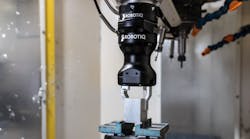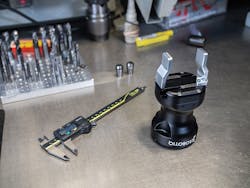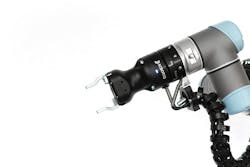When it comes to robotics, carmakers are not bashful about investing time and resources to ramp up a production cycle. As Robotiq CTO Jean-Philippe Jobin explains, they design lines for seven-year loops, drawing from the combined intelligence and manhours of a hundred or more engineers, installing brand new infrastructure to run pneumatics, hydraulic, and electrical power. Whatever it takes to get the job done, they do it.
That’s just not feasible for smaller companies working on higher volumes of components that can change on a year-to-year, or more likely, month-to-month basis, a machine shop or electronics assembler, for example. Everything matters and must be considered.
“Many manufacturers really struggle to put robots in their factory because it’s too costly and too complicated,” says Jobin, who co-founded the Quebec-based Robotiq a decade ago this July.
If you’re a small or medium-sized enterprise (SME) who figured a way around this, that’s great and another example of fortune favoring the bold. It’s still a sobering reminder that the little guys and gals who support all the big companies, and really needs robotics to stay ahead can’t always do so. Furthermore, getting enough human workers for your assembly line or pick-and-place operation has been a recurring struggle. That’s exactly why Robotiq was created, and why the company just launched a new electric parallel gripper in late June, called the Hand-E.
The compact 50-mm stroke grippers are the strongest you’ll find in their size and power class, with a grip force of 60 to 130 newtons and 5 kg form-fit grip payload. They are plug-and-play, with set-up time under 10 minutes and they easily attach to Robotiq’s FT 300 force torque sensor for machine tending on CNC machines, or a wrist camera for precise pick-and-place of small electronics. With no sharp edges or pinch points, they are perfect for collaborative robots.
It was designed to work seamlessly with Universal Robots new e-Series cobots, also announced at the Automatica 2018 in Munich. The e-series takes an hour to unpack and program and can be plugged into a conventional electrical socket.
Two larger previous models in the Adaptive Gripper line, the 2F-85 and 2F-140, also will work with the e-series.
“The big difference with the Hand-E is that we upgraded the software and you have [the Universal Robots] interface in which you enter the dimensions and all the rest is done behind the scenes,” Jobin says.
As with the latest crop of intuitive software, an operator taps stylus to tablet a few times and the robot and gripper do the rest. No longer does a manufacturer need to rely on a team of engineers and technical specialists.
“This opens up for less technically experienced workers to get the same results,” Jobin says.
The force, speed, and position are all configurable, with the grippers excelling at part detection and part validation
The IP67-rated grippers are so precise, Jobin says, that in a pick-and-place experiment, the Hand-E could easily sort 47 and 48-mm PCBs in to two distinct piles. In another test, the Hand-E was able to thread a tiny wire through a hole, only possible with its increased force sensing functionality.
If the gripper senses the part is bad, you can program the robot to place the part in a reject bin. Getting the dimensions right is vital when collaborating with machine tool. If the metal block were to slip and be incorrectly placed on the workholding, a jam could occur, slowing production.
“The goal of Robotiq is too simply help them install robots and help them start their production faster,” Jobin says. “If you are able to start one month earlier, it will make a big difference.
Jobin should know. After he and CEO Samuel Bouchard graduated from Laval University, they traveled the world to understand the needs robots would solve, then lugging around suitcases full of end-effector prototypes to U.S. businesses to get their startup off the ground.
Since then, Robotiq has become an influential voice in the robotics community, with Jobin joining the board of the ISO committee for robot safety, and Bouchard authoring Lean Robotics, a book to help manufacturers systematically and intelligently deploy an automated workforce.
The book is obviously just an extension of the company’s mission statement, while the Hand-E is the latest execution.
The most visible improvement is space reduction in the work cell, as there’s no need for pneumatic air, compressors, or airline. Installation time and costs, along with eliminating maintenance on regulators and valves, and finding air leaks, are also gone. The tradeoff is that electric grippers are less powerful than hydraulic and pneumatic counterparts, so they won’t work for every application.
They do come with fingertips starter kit with three kits, so the number of applications is quite broad.
“That’s a big customization the end user will want to do,” Jobin says. “Probably 50% will design own. They can machine from the kit, creating the groove or slot for the part they want to grip. And we provide digital file on website of all grippers and do modification they need.”













